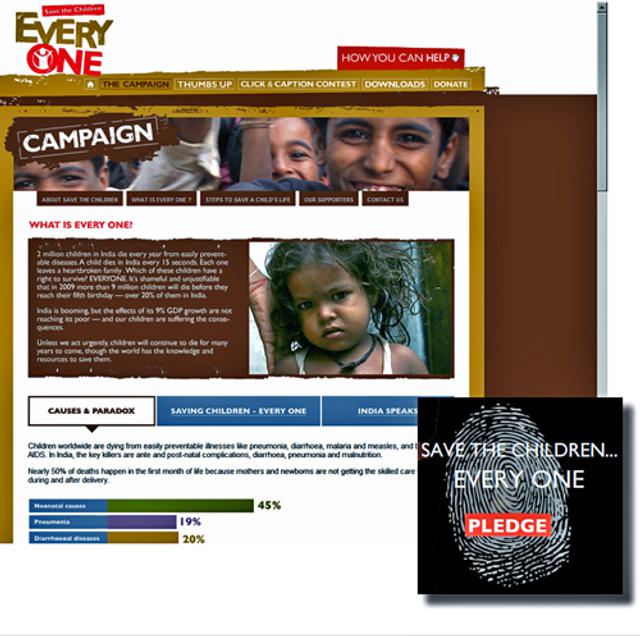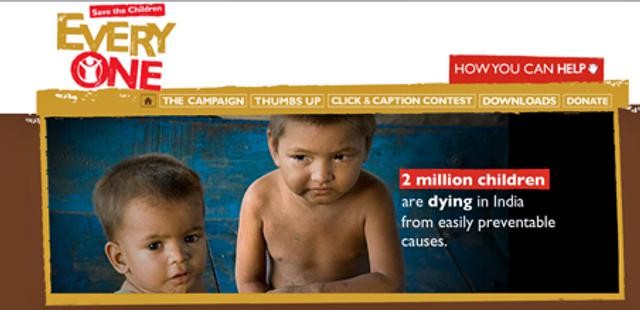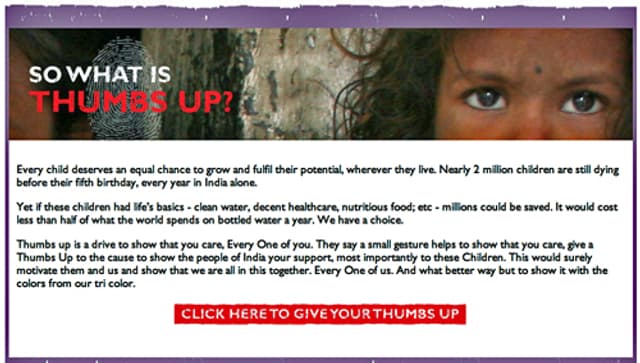Save the Children India: the ‘Every One’ campaign to reduce child deaths
- Exhibited by
- Sattva.
- Added
- June 11, 2012
- Medium of Communication
- Target Audience
- Awareness
- Type of Charity
- Children, youth and family, international relief/development, public/society benefit
- Country of Origin
- India
- Date of first appearance
- October, 2009
SOFII’s view
Few campaigns in the entire world could be more important than one that focuses on the need to reduce avoidable child deaths. Save the Children has an impressive track record and credentials in this crucial work and this campaign from India is particularly inspiring and instructive. Though still in its early stages, about 100,000 people have signed up to support the cause within just three weeks of the campaign launch and a new kind of dialogue has been created across a wide range of media. So the campaign’s ambitious targets are now beginning to seem achievable.
Summary / objectives
Save the Children (SC) is the world’s leading independent organisation for children. It works to inspire breakthroughs in the way the world treats children to achieve immediate and lasting change in their lives. Save the Children was established in 1919 and currently is in more than 120 countries with 30 member nations.
The organisation has been in India for over seven decades and the strategic focus areas for the organisation are child survival, child protection, education, responding to emergencies and disaster risk reduction.
Currently more than eight million children die every year due to causes like poor neo-natal care, diarrhoea, pneumonia and malaria. In India 1.8 million children die each year, the highest number in the world. Most of these children can be saved through low cost solutions.
On October 5, 2009 Save the Children launched a global campaign to reduce the number of deaths among children aged under five. The campaign, called EVERY ONE, aims to do this through programmatic interventions, increased awareness about the issue and by accelerating the required changes in policy and attitudes needed to achieve the fourth Millennium Development Goal (MDG4) of a two-third reduction in the deaths of children by 2014.
Background
Nearly two million children in India die every year from easily preventable diseases. However, there is very little awareness about this tragedy among middle-class families in India. A recent survey carried out by Save the Children showed that about 80 per cent of the respondents thought the number of deaths was less than a quarter of the actual figure.
Through both online and face-to-face contact, the EVERY ONE campaign aims to remedy this disparity by focusing on child mortality.
The campaign involves four key aspects
- Grassroots intervention – working with the government and those in need.
- Popular mobilisation – increasing awareness about children dying.
- Influencing policy – creating petitions and communicating with the right offices in the government.
- Fundraising – through corporate partners and door-to-door fundraising.
Rather than concentrating on one of these aspects, the campaign integrates all four to ensure maximum impact.
As part of their popular mobilisation efforts, Save the Children India primarily focuses on raising awareness among young people and encourages them to join the campaign and to speak up about it. With this target audience in mind, they introduced the following channels, all of which are perfectly positioned to attract young people’s attention.
The EVERY ONE microsite outlines the aim of the campaign and substantiates it with relevant and powerful statistics. It is also an involvement platform for people to show their support for the initiative. They are invited to take a pledge and to leave a virtual thumbprint. Each thumbprint shows that person’s promise to EVERY ONE. They are also asked to give their basic details – name, gender and e-mail address. Visitors to the site can also take part in the ‘click and caption contest’ by submitting photos with a caption that express their thoughts and views on the subject. The submitted photos can be viewed through links on the website.
A ‘shopping list’ of needs and their costs shows potential donors how their money will be used. For instance, how rupees 5000 can provide the young mother and her new born with health care and adequate nutrition for the first three months.
Save the Children partnered with the DLF Foundation, the CSR initiative of a leading real estate company, and Inorbit, owners of shopping malls in India, to organise activities that would raise awareness, gather support and instigate actions related to the rights of children. A huge wall was set up in various DLF Foundation offices in Delhi and Inorbit malls in Mumbai where people could leave a thumbprint to show support for the campaign and again leave basic contact details.
Vinod Gupta School of Management, which is associated with the Indian Institute of Technology in Kharagpur, organised ‘Saamanjasya (which means collaboration) 2010’. The aim was to bring together companies and NGOs on a common platform to ensure inclusive growth and to inspire young people with the idea of giving back to society. Save the Children India joined in with Saamanjasya to encourage young people’s participation in the EVERY ONE campaign. Students from diverse backgrounds, including law, humanities, engineering and management, joined the three-day event in March 2010.
Special characteristics
Save the Children India aims to increase awareness about child mortality, influence policies on child welfare as well as raise funds. By running one unified campaign aimed at all of these goals, they are able to reach a wide audience as well as create cooperation across initiatives to ensure that they make the most out of their efforts.
The EVERY ONE campaign brings together a variety of activities as an integrated effort towards reducing child mortality. While the channels of interaction are different (online and offline), the campaign uses similar ways to provide a unified experience. For instance, leaving thumbprints on a real wall and, online, on a virtual wall. Leaving a thumbprint is effective since it serves as an act of support while also making it easier for someone to volunteer for the cause.
Once they leave a pledge, people are offered the choice to donate funds, organise fundraising campaigns, or just be kept in touch about the campaign activities. They can also stay in contact with EVERY ONE through Facebook. Thus the campaign builds a broad community of supporters.
Save the Children India uses the results of one activity to further another. For instance, they asked those who had left a thumbprint to support their petition to the government and the fundraising drive during the Delhi and Bangalore marathon.
The campaign increased awareness of child mortality through effective use of statistics, for example, ‘nearly two million children in India die every year from easily preventable diseases. A child dies in India every 15 seconds’clearly shows that it is a widespread and rampant problem. By stating that for every hundred children who die globally, 22 are from India alone, they emphasise that the problem is especially acute in India.
The campaign emphasises that the reasons for such deaths are causes that can be very easily treated. For instance, diarrhoea is the second most common reason for deaths, but only 26 per cent of children are given rehydration salts or fluids that can stop the illness from becoming fatal.
In addition, by aligning with the Millennium Development Goals, the campaign puts forward a clear goal of a two-third annual reduction in the deaths of children by 2014.
Influence / impact
The campaign has generated considerable interest both through online and offline interactions. Over 100,000 people left their thumb impressions on the online portal in three weeks. Over 14,000 people left their thumbprints on the walls in Delhi and Mumbai.
Costs
The organisation has forged a lot of strategic partnerships to offset the costs of the campaign. The corporate supporters include Inorbit Malls, DLF Foundation, Exchange4media.com, Reckitt Benckiser, Vitol, Bright Outdoor media Pvt. Ltd, Pepsico foundation, DSN and Vicks.
Airtel, one of India’s largest mobile service providers, sponsored sending two million text messages to people about the campaign. The campaign also had some endorsements from leading film celebrities creating a lot of visibility in the media. In addition, media channels donated airspace for raising awareness about the campaign.
Organisations such as IKEA sponsored specific events in different states, or a focused pneumonia campaign.
Results
Variations of the EVERY ONE campaign – along with the thumbprint – are now active in other parts of the Save the Children alliance.
Merits
With the increased use of the internet, proliferation of online social networks and communication tools such as Twitter, there is a fundamental shift in mobilising funds and resources. Rather than seeking individual donors, organisations can build communities that stand by their idea and can then contribute to furthering the cause in many ways.
The key to building such a community is to have a simple and relevant message that brings down barriers to volunteering and sustains the community through continuous involvement. The EVERY ONE campaign has been able to achieve this through its effective messaging and integrated campaign combining both offline and online interaction.
 View original image
View original image
Also in Categories
-
-





















